
redis is a Nosql database and a key-value storage system. Although redis is a key-value storage system, redis supports many value storage types, such as strings, linked lists, sets, ordered sets, and hashes.
Redis is a key-value storage system. Similar to Memcached, it supports relatively more stored value types, including string (string), list (linked list), set (set), zset (sorted set - ordered set) and hash (hash type). These data types all support push/pop, add/remove, intersection, union, difference, and richer operations, and these operations are all atomic. On this basis, redis supports various different ways of sorting. Like memcached, data is cached in memory to ensure efficiency. The difference is that redis will periodically write updated data to disk or write modification operations to additional record files, and on this basis, master-slave (master-slave) synchronization is achieved.
Redis is a high-performance key-value database. The emergence of redis has largely compensated for the shortcomings of key/value storage such as memcached, and can play a very good supplementary role to relational databases in some situations. It provides Java, C/C, C#, PHP, JavaScript, Perl, Object-C, Python, Ruby, Erlang and other clients, which is very convenient to use.
Redis supports master-slave synchronization. Data can be synchronized from the master server to any number of slave servers, and the slave server can be a master server associated with other slave servers. This allows Redis to perform single-level tree replication. Saving can write data intentionally or unintentionally. Since the publish/subscribe mechanism is fully implemented, when the slave database synchronizes the tree anywhere, it can subscribe to a channel and receive the complete message release record of the master server. Synchronization is helpful for scalability and data redundancy of read operations.
Redis is completely open source and free, complies with the BSD protocol, and is a high-performance key-value database.
Redis supports five data types: string (string), hash (hash), list (list), set (set) and zset (sorted set: ordered set).
Redis and other key-value caching products have the following three characteristics:
Redis supports data persistence. It can save the data in the memory to the disk and load it again when restarting. for use.
Redis not only supports simple key-value type data, but also provides storage of data structures such as list, set, zset, and hash.
Redis supports data backup, that is, data backup in master-slave mode.
Advantages of Redis
Extremely high performance – Redis can read at a speed of 110,000 times/s and write at a speed of 81,000 times/s.
Rich data types – Redis supports Strings, Lists, Hashes, Sets and Ordered Sets data type operations for binary cases.
Atomic – All Redis operations are atomic, meaning they are either executed successfully or not executed at all. Individual operations are atomic. Multiple operations also support transactions, that is, atomicity, wrapped by the MULTI and EXEC instructions.
Rich features – Redis also supports publish/subscribe, notifications, key expiration and other features.
What is the difference between Redis and other key-value stores?
Redis has more complex data structures and provides atomic operations on them. This is an evolutionary path different from other databases. Redis's data types are based on basic data structures and are transparent to programmers, without the need for additional abstractions.
Redis runs in memory but can be persisted to disk, so memory needs to be weighed when performing high-speed reading and writing of different data sets, because the amount of data cannot be larger than the hardware memory. Another advantage of in-memory databases is that compared to the same complex data structures on disk, operating in memory is very simple, so Redis can do a lot of things with strong internal complexity. Also, in terms of disk format they are compact append-generated since they do not require random access.
So why use a Nosql database like redis?
1. When the total size of the data cannot fit in one machine;
2. When the data index cannot fit in the memory of one machine;
3. The number of visits (read Write mixed) when one instance cannot fit.
In the stand-alone era, only one machine is used to install MySQL for storage. If thousands of pieces of data are stored each time, this will cause MySQL's performance to be poor, storage and reading speeds to be very slow, and then it will evolve. Into the way of vertical splitting of cache mysql.
Cache, as an intermediate cache era, saves all data in the cache first and then stores it in mysql to reduce database pressure and improve efficiency.
But when the data increases to another magnitude again, the above method cannot meet the demand. As the writing pressure of the database increases, the cache can only relieve the reading pressure of the database. The concentration of reading and writing on one database makes the database overwhelmed. Most websites have begun to use master-slave replication technology to achieve separation of reading and writing to improve reading and writing performance and the scalability of the reading database. Mysql's master-slave mode has become the standard for websites at this time.
In the era of master-slave separation mode, on the basis of redis cache, MySQL master-slave replication, and read-write separation, the write pressure of the MySQL main database began to appear bottlenecks, and the amount of data continued to surge. MyISAM uses table locks, which can cause serious lock problems under high concurrency. A large number of high-concurrency MySQL applications have begun to use the InnoDB engine instead of MyISAM. Advantages of Nosql database:
1. Easy to expand
These types of data storage do not require a fixed mode and can be expanded horizontally without redundant operations. Compared with relational databases, the number of tables and fields can be reduced. It also brings scalable capabilities at the architectural level
2. Large data volume improves performance
3. Diverse and flexible data models
The above is the detailed content of Why should web projects introduce redis?. For more information, please follow other related articles on the PHP Chinese website!